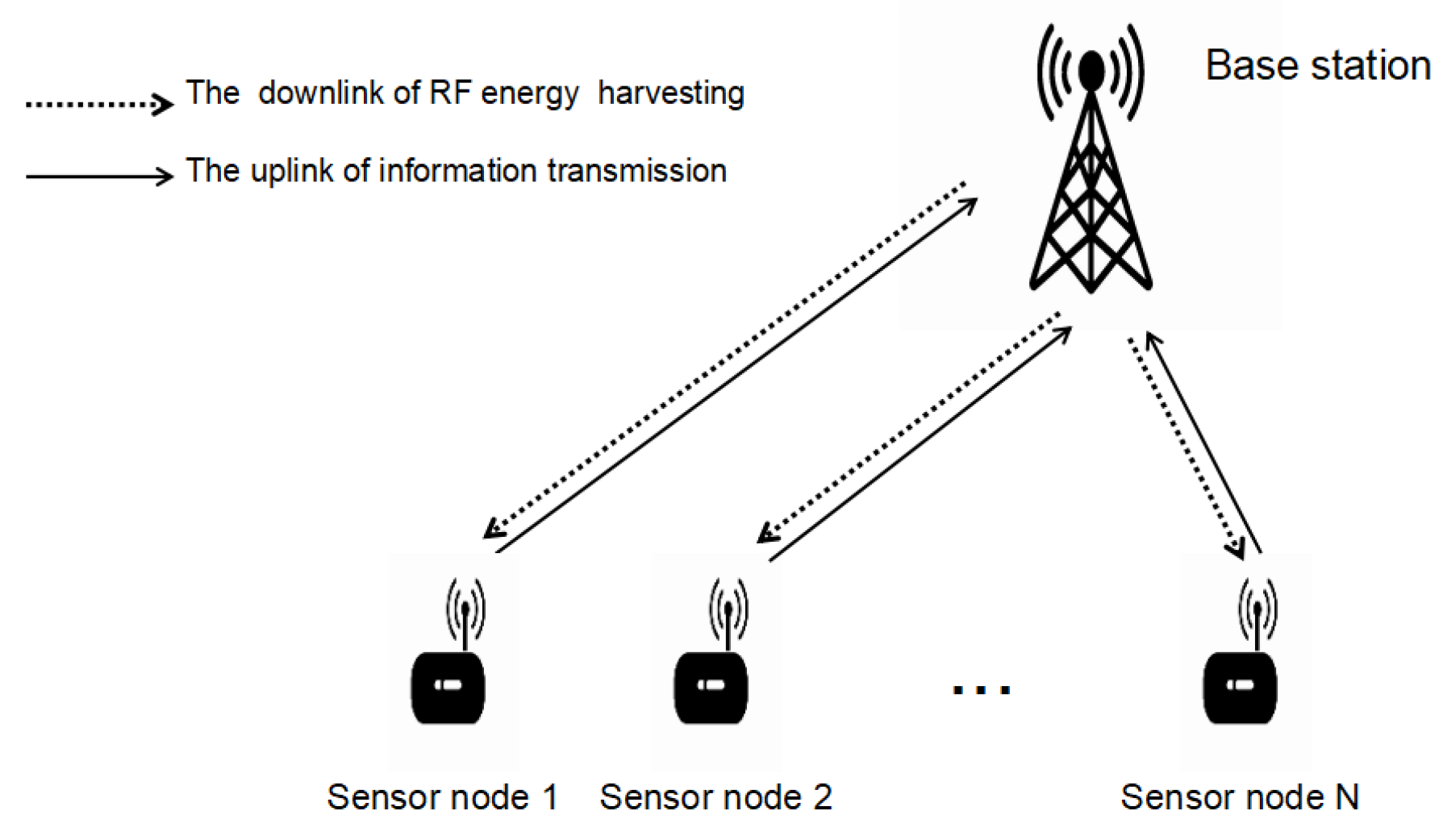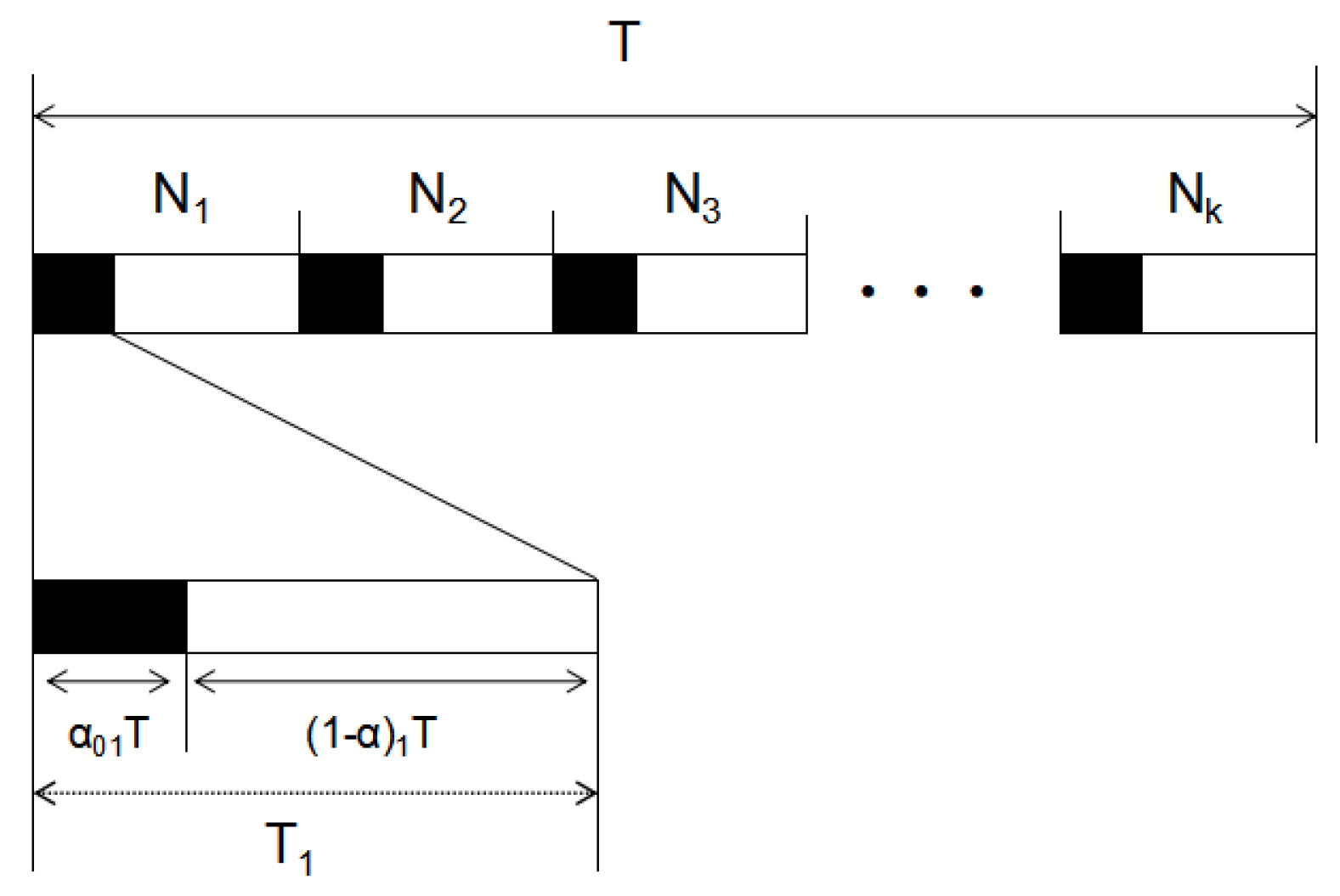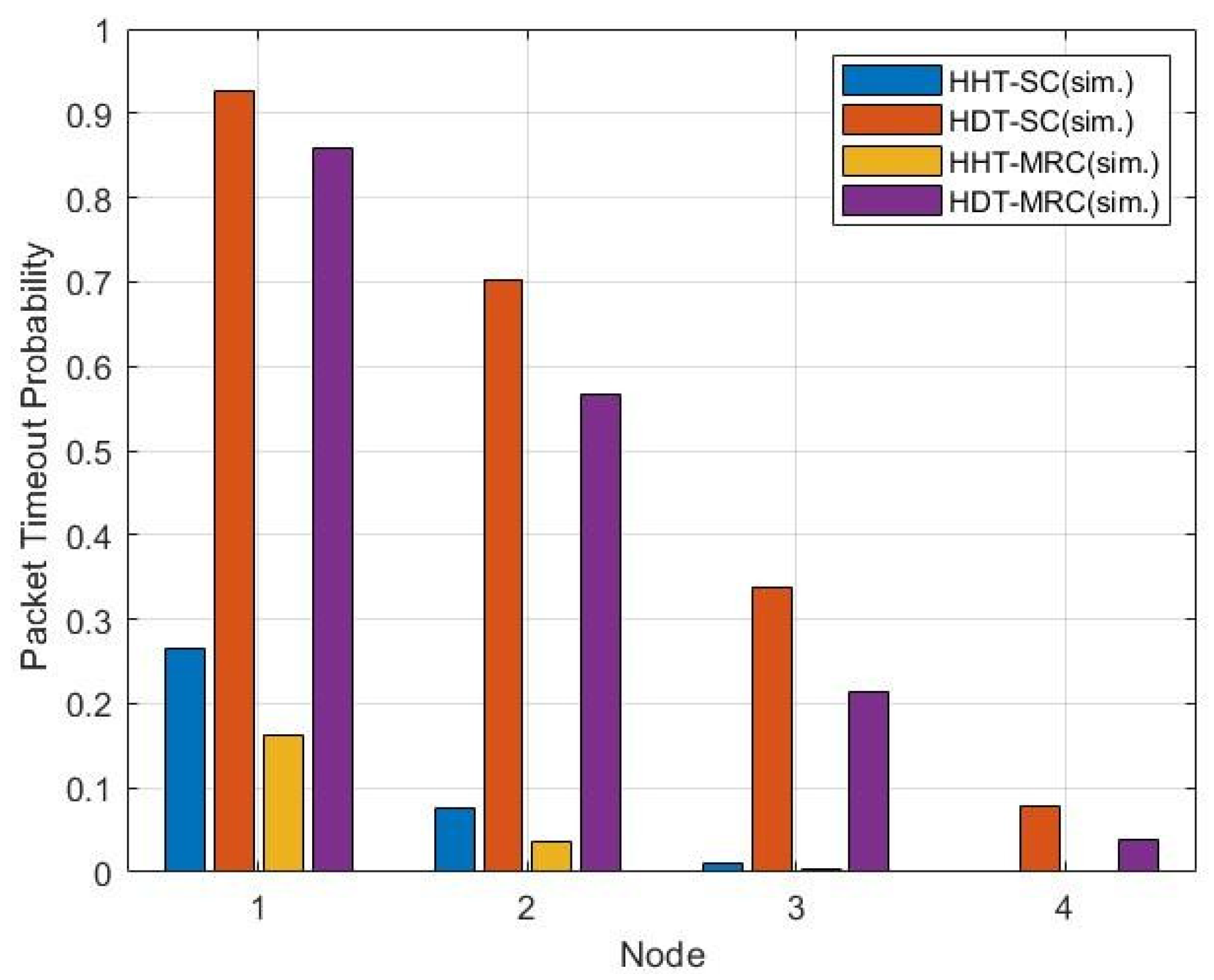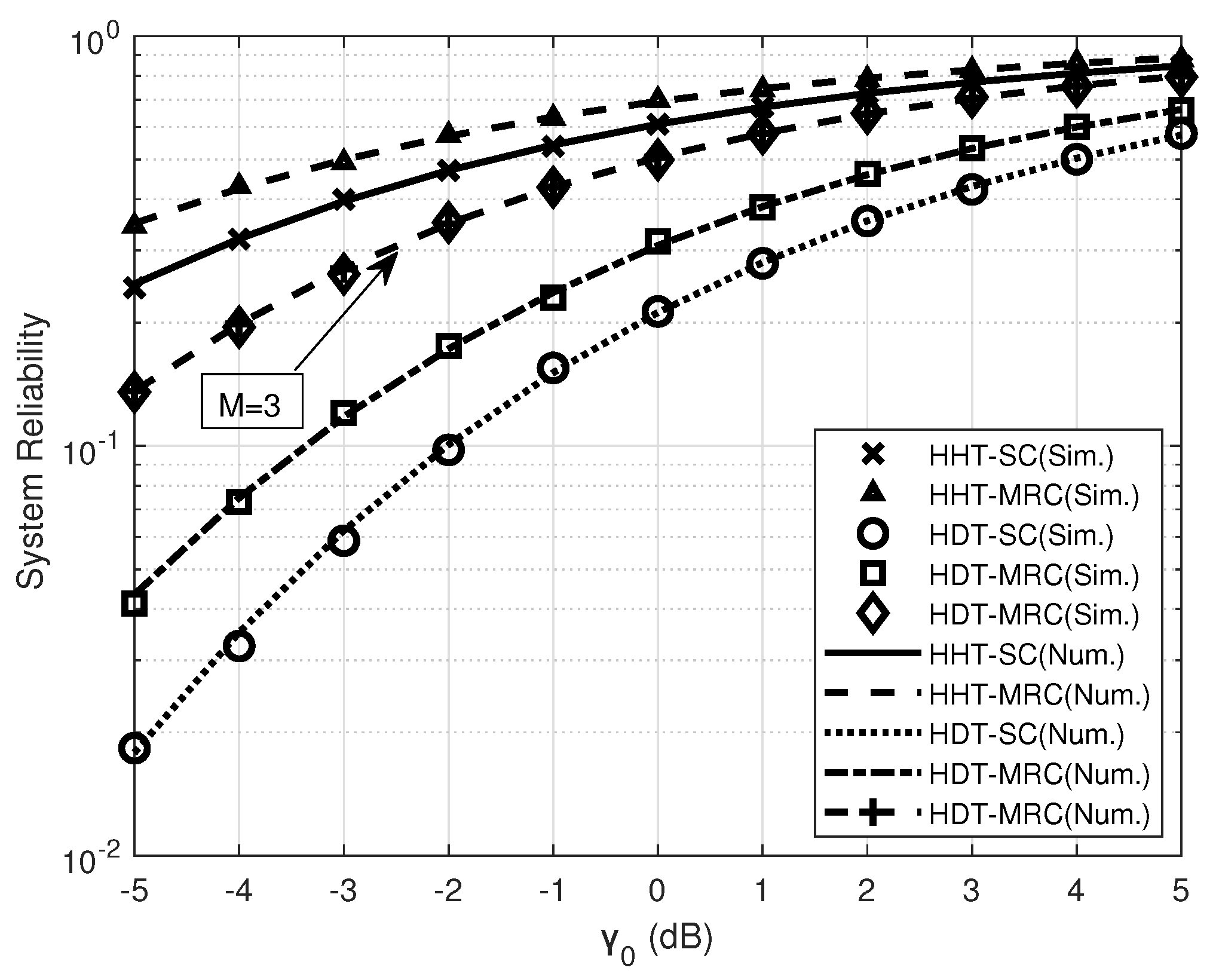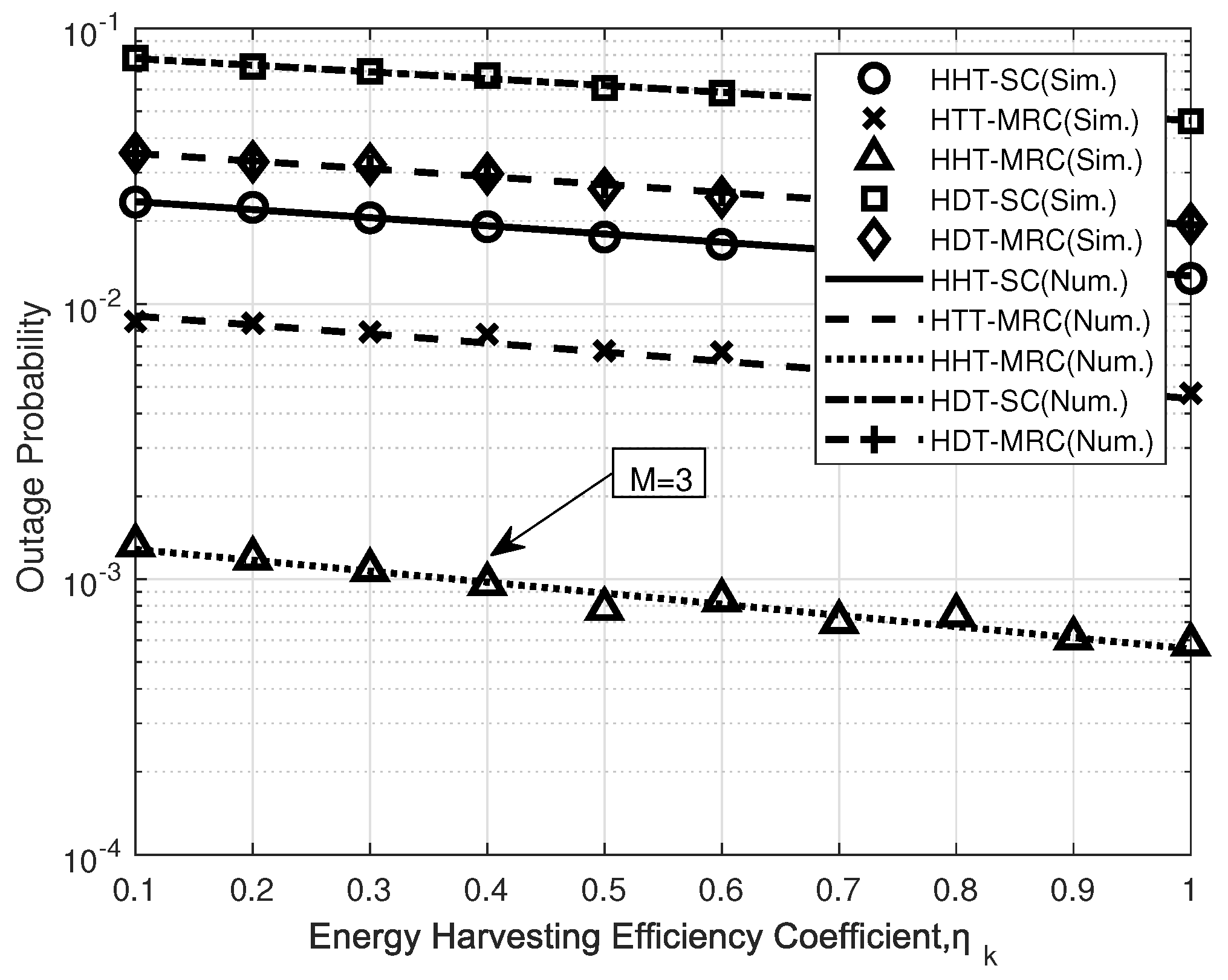1. Introduction
Wireless communication has attracted substantial attention in recent years as a promising field of research due to its versatility and economic benefits, particularly with the advent of sixth-generation (6G) communications. As a result, wireless sensor networks have found extensive applications in various aspects of our lives, such as medical, industrial manufacturing, and the Internet of Things (IoT) [
1,
2,
3,
4]. However, there are still issues that need to be addressed in wireless communication systems, such as equipment service life, complex environments, and the impact of channel states on energy harvesting and information transmission [
5,
6].
The topic of energy harvesting is constantly in the news, as we need energy in all aspects of our lives. While renewable energy sources such as wind, solar, and hydraulic potential are frequently used, some devices, such as artificial hearts and forest monitoring systems, cannot easily compensate for the lack of energy. Therefore, radio frequency (RF) wireless energy harvesting and usage have become a primary research topic in these fields. In an RF wireless energy harvesting system, the uplink information transfer and the downlink wireless energy harvesting are limited, leading to unsatisfactory system performance and restrictions [
7]. Therefore, it is essential to distribute the time for sending packets and energy harvesting consistently to reduce the impact on system performance [
8].
Energy-harvesting technologies have shown great potential in powering small electronic devices without the need for external power sources. However, existing energy-harvesting devices suffer from large size and low power conversion efficiency. To address these challenges, a better approach to energy harvesting was proposed in paper [
9], that is, metasurfaces and metamaterial structures are proposed as collectors for energy-harvesting devices that provide higher conversion efficiency in smaller sizes. One such example is the bow-tie multi-band rectenna with slots proposed in a paper by Agrawal et al. This rectenna is designed for ambient wireless energy harvesting for autonomous IoT sensors, featuring a high-conversion-efficiency multi-band rectification circuit composed of four single-ring rectifiers. The paper also proposes a power management circuit to store and convert the harvested voltage, smoothing the direct current (DC) output voltage and improving system performance [
10].
The design of energy-harvesting devices must meet certain standards to ensure optimal system performance. In this regard, Wagih et al. divided the rectenna into antenna rectification impedance bandwidth and antenna radiation characteristics, in accordance with wireless power transfer (WPT) and antenna design for environmental RF energy harvesting application standards [
11]. In another paper, the non-orthogonal multiple access (NOMA) protocol is studied to transmit IoT relay node data together with source node data in the presence of interfering signals. The outage probability, throughput and total throughput are mathematically derived, and a representative performance comparison method is given [
12]. Finally, a paper by Liu et al. presents the design of a three-band high-gain multi-beam ambient RF energy-harvesting system utilizing hybrid combination. This system maximizes the use of harvested RF energy by utilizing frequency, space, and polarization simultaneously. A broadband hybrid combination is proposed that enables energy harvesting at low RF power densities while maintaining the wide frequency and spatial coverage required for ambient RF energy harvesting [
13]. In paper [
14], the limited sensitivity and nonlinearity of far-field RF energy harvesting are presented and their effects quantified. Furthermore, a linear model and two nonlinear models are proposed, and the differences in wireless information and power transfer designs for each model are shown in single-user and multi-user deployments [
15].
RF energy-harvesting technology is widely used in the Internet of Things, and many advanced energy harvesting technologies have been proposed in these applications [
16,
17,
18,
19]. RF energy-harvesting systems face two significant challenges: system reliability and packet timeout probability. To address these problems, researchers have proposed several solutions, including improving system performance in wireless sensor networks through the Low-Energy Adaptive Clustering Hierarchy (LEACH) protocol [
20] and analyzing interrupt performance in wireless sensor networks [
21]. In particular, Tran proposed a system performance research method in [
22] using two energy-harvesting protocols: the head harvesting energy of each timeslot (HHT) and the head harvesting energy of a dedicated timeslot (HDT). Researchers can choose a protocol that is more suitable for communication by contrasting the system performance of the HHT protocol under maximal ratio combining (MRC) and selection combining (SC) techniques with the HDT protocol under MRC and SC technology. According to [
22], the HDT protocol harvests energy during a designated time slot, whereas the HHT protocol harvests energy at the head of the time slot. The energy-harvesting time is
and
, and
, where
K is the number of sensor nodes. The size of the transmitted packets is the same for both the HHT and HDT protocols in paper [
22], where the size of the packet transmitted by the system is set to
L. Given that the HDT protocol harvests energy over a significantly longer period than the HHT protocol, this can lead to an unfavorable contrast. Moreover, the complex channel characteristics that apply to both MRC and SC technology are not taken into account in study.
In response, we reformulate the optimization problem put out in [
22] in order to solve these problems, and we offer competitive energy-harvesting strategies in this reformulated problem. To determine which protocol is best for the energy-harvesting system, different packet sizes are assigned to various protocols, and then, they are compared once more. The research findings of paper [
22] show that the HDT protocol performs better than the HHT protocol. Our improved simulation results, however, show that HHT performs better and is more suited for RF wireless communication, particularly the HHT protocol using MRC technology. It is appropriate, and the following analysis provides a detailed examination.
5. Numerical Results
This section presents the analysis and simulation results for our system. We focus on evaluating our proposed performance metrics, which include the system reliability, packet timeout probability, and outage probability for both the HHT and HDT protocols. Due to the randomness of the channel state, we use Monte Carlo simulation technology for our analysis. To ensure accuracy, we sample a total of
loops, and the system parameters are set according to
Table 1.
In
Figure 4, we analyze the impact of different distances between the BS and the sensor nodes on the packet timeout probability. We set the coordinates of the four nodes as
,
,
, and
. The energy-harvesting time of the HHT protocol is
, while that of the HDT protocol is
. The packet transmission time for both protocols is
. According to our observation, node 4 performs the best out of all nodes, due to its lowest packet timeout probability. This is the case since node 4 can harvest the most energy and has more energy available for packet transmission because of the fact that the distance between it and the BS is the shortest. Furthermore, we note that the packet timeout probability under the HHT protocol is consistently lower than that under the HDT protocol for all nodes. At the same time, under the same conditions, the packet timeout probability using MRC technology is lower than that using SC technology. This is because MRC selected the maximum value of channel gain, which has a higher channel gain than the average value of channel gain selected by SC. Additionally, the packet timeout probability of the MRC technology in the HHT protocol is lower than that of the SC technology in the HHT protocol, and the system performance of the HHT protocol using MRC technology is the best under the same distances.
In
Figure 5, we examine the impact of energy harvesting effectiveness between single sensors on the packet outages probability for the system. According to [
22], we set the coordinates of the sensor nodes to a fixed point
. We adopt the univariate research concept and set the number of antennas and nodes as
and
, respectively. We assign four different energy harvesting efficiencies to four sensor nodes, namely
,
,
, and
. Additionally, the energy-harvesting times for the HDT protocol and the HHT protocol are denoted as
and
, respectively. Our observations indicate that increasing the energy harvesting efficiency leads to a decrease in the packet timeout probability for both the HHT and HDT protocols. This is because higher energy-harvesting efficiency allows sensor nodes to harvest more energy, which in turn enables them to use more energy for information transmission. This reduces the packet loss rate and leads to improved system performance. Moreover, we have observed that the packet timeout probability of the HHT protocol is consistently lower than that of the HDT protocol under the same energy harvesting efficiency conditions. This can be attributed to the fact that the HHT protocol uses a more refined time slot division and is therefore more sensitive to channel variations. Thus, the performance of the HHT protocol is generally better than that of the HDT protocol under similar conditions.
In
Figure 6, we investigate the system reliability of the HHT and HDT protocols. where the information transmission time is
, the coordinates of the sensor nodes are set to
[
22], and the energy-harvesting time for the HHT protocol and the HDT protocol is
and
, respectively, and the energy-harvesting efficiency is
. The figure clearly indicates that as SNR
increases, so does the system reliability. This is because an increase in SNR results in more energy being harvested by sensor nodes, which is then used for uplink information transmission, resulting in improved system performance. Furthermore, we observe that the system reliability of the HHT protocol is higher than that of the HDT protocol at the same SNR. This is due to the fact that the HHT protocol harvests energy at the head of each segment, which is less affected by channel status than the HDT protocol, which harvests energy at the head of the total period. Similarly, we also found that under the condition of HHT protocol, the system reliability using MRC technology is better than that of using SC technology. This is because the MRC selects the maximum value of the channel gain, which has a higher channel gain than the average value of the channel gain selected by the SC, which results in the system being able to harvest more energy for information transmission. We can also observe that increasing the number of antennas from
to
increases system reliability by utilizing the HDT protocol with MRC technology.
Figure 7 depicts the impact of energy-harvesting time length on the system reliability of the HHT and HDT protocols in the complete system. We fix energy-harvesting efficiency as
, and the coordinates of the sensor nodes are set to
. The figure shows that extending the energy-harvesting time increases the system reliability. This is because the sensor nodes can obtain more energy from the BS, reducing the data packet loss rate during data transmission and improving system performance. Furthermore, we have consistently observed that the HHT protocol outperforms the HDT protocol in terms of system reliability regardless of the energy-harvesting time length. This is because the HHT protocol uses a more reasonable time allocation method, allocating energy-harvesting time at the head of each time slot, and is less affected by complex channel environments. Additionally, the HHT protocol utilizes MRC technology, which results in the highest system reliability and best system performance.
Figure 8 shows how the energy-harvesting efficiency coefficient affects the probability of a system outage in our wireless communication system. Specifically, we fix the energy-harvesting time for the HHT and HDT protocols at
and
, respectively, and set the information transmission time as
. The energy-harvesting efficiency is held constant at
. Our simulation results demonstrate that increasing the energy-harvesting efficiency leads to a continuous decrease in the outage probability in our wireless communication system, as shown in
Figure 8. Furthermore, the HHT protocol consistently outperforms the HDT protocol in terms of lower outage probability. This superiority can be attributed to the fact that the HHT protocol harvests energy at the beginning of each time slot, which is less susceptible to channel fading. Consequently, more energy is available for information transmission, resulting in a reduced outage probability. Additionally, we discovered that when the number of antennas is increased from
to
, the probability of a packet outage is greatly reduced because doing so enables the system to obtain greater diversity gain. Therefore, based on our simulation results, we can conclude that the HHT protocol is a preferable option for energy harvesting in wireless communication systems, as it achieves better system performance compared to the HDT protocol.
6. Conclusions
In this paper, we present a system model for energy harvesting and information transmission in wireless communication, which utilizes two protocols in the energy-harvesting part of the downlink, namely the HHT and HDT protocols. Our main objective is to compare and analyze the system reliability, packet timeout probability, and outage probability of these two protocols to evaluate their performance. Moreover, we simulate the proposed system using the Monte Carlo simulation method based on the channel state. Our simulation results indicate that the HHT protocol outperforms the HDT protocol in terms of system reliability, packet timeout probability, and outage probability. Specifically, the HHT protocol demonstrates higher system reliability and lower packet timeout and outage probabilities compared to the HDT protocol under similar conditions. Therefore, the HHT protocol with MRC technology is considered optimal for our proposed system.
In our future work, we plan to apply our research results to artificial hearts and other medical fields, which may lead to unexpected benefits. This could potentially alleviate the current limitations for artificial heart recipients who are hesitant to venture far from urban areas due to concerns about timely energy replenishment as well as improve their quality of life. Additionally, the effective utilization of RF energy harvesting could bring new changes to our 6G smart era and provide a new way for people to experience the relative abundance of energy in their daily lives.
